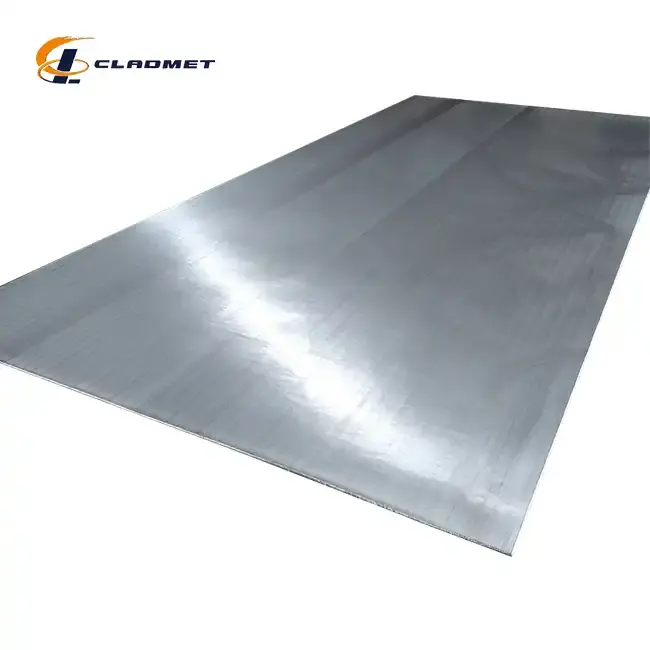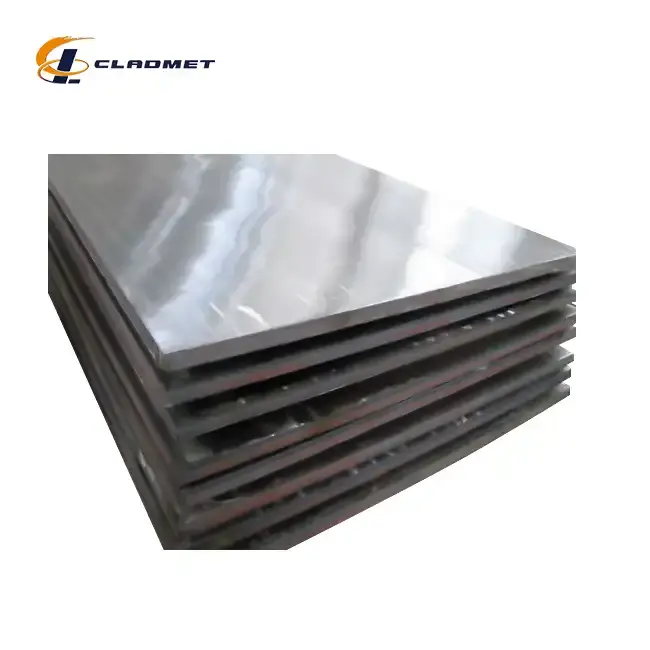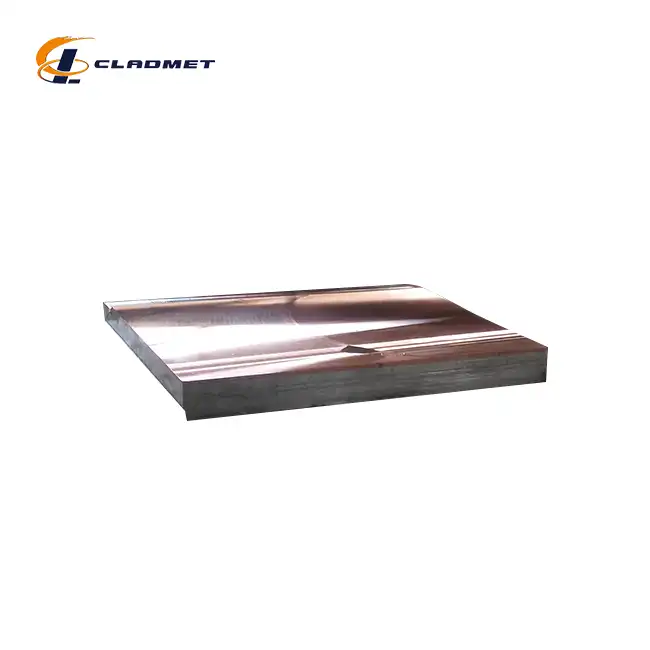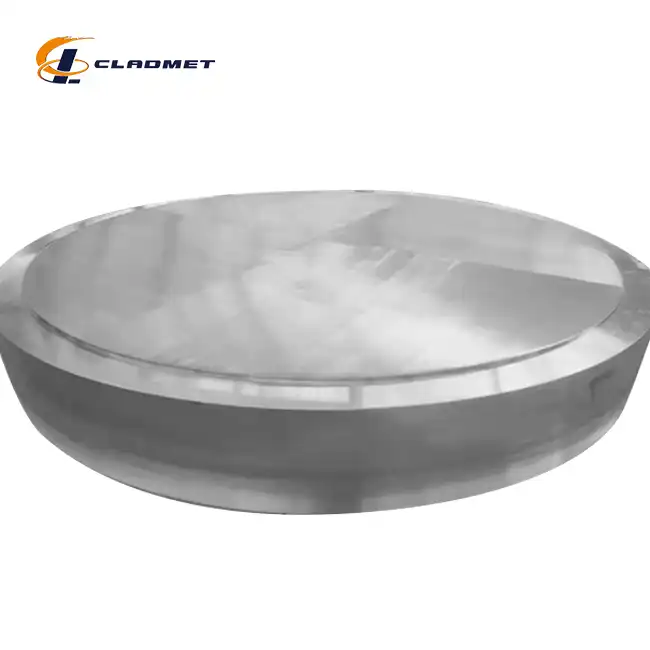How Do Steel Clad Plates Combine Strength and Corrosion Resistance Effectively?
 2025-07-10 13:07:00
View:389
2025-07-10 13:07:00
View:389In today's demanding industrial landscape, engineers and manufacturers face the constant challenge of finding materials that can withstand harsh environments while maintaining structural integrity and cost-effectiveness. Steel clad plates have emerged as a revolutionary solution that successfully addresses this challenge by combining the inherent strength of steel substrates with the superior corrosion resistance of specialized cladding materials. These composite materials represent a significant advancement in metallurgical engineering, offering industries a way to achieve optimal performance without compromising on durability or economic viability. The steel clad plate technology enables manufacturers to harness the best properties of multiple metals in a single, integrated product that meets the stringent requirements of modern industrial applications.

Advanced Manufacturing Techniques for Superior Performance
Explosive Bonding Technology for Maximum Adhesion
Explosive bonding represents one of the most sophisticated manufacturing processes used in creating high-performance steel clad plates. This technique utilizes precisely controlled explosive charges to create an instantaneous, high-velocity impact that permanently fuses the base steel substrate with the cladding material at a molecular level. The process begins with meticulous preparation of both the steel plate and the cladding material, ensuring that all surfaces are completely clean and free from contaminants that could compromise the bond integrity. The explosive setup involves strategic placement of explosive charges between the materials, calculated to generate the exact amount of force required for optimal bonding without causing structural damage to either component. When the explosion occurs, it creates an intense pressure wave that causes the materials to collide at velocities exceeding 500 meters per second, resulting in a metallurgical bond that is often stronger than either of the parent materials alone. This steel clad plate manufacturing method is particularly advantageous for applications requiring exceptional bond strength, such as those found in petrochemical processing equipment and offshore drilling platforms where equipment failure could have catastrophic consequences.
Roll Bonding Process for Industrial Applications
Roll bonding represents a highly controlled cold-working process that creates steel clad plate through the application of tremendous pressure via heavy industrial rollers. This manufacturing technique begins with thorough surface preparation of both the base steel material and the cladding layer, involving chemical cleaning, mechanical preparation, and sometimes specialized surface treatments to ensure optimal bonding conditions. The materials are then fed through a series of powerful rollers that apply pressure measured in tons per square inch, causing plastic deformation at the interface between the two metals. This deformation creates microscopic interlocking between the surface features of both materials, while simultaneously work-hardening the interface to create a robust mechanical bond. Multiple passes through progressively adjusted rollers may be necessary to achieve the desired bond strength and uniformity across the entire steel clad plate surface. The roll bonding process is particularly well-suited for producing steel clad plates used in chemical processing industries, where consistent corrosion resistance across large surface areas is critical for long-term performance and safety.
Hot Isostatic Pressing for Aerospace Applications
Hot Isostatic Pressing (HIP) represents the pinnacle of steel clad plate manufacturing technology, combining elevated temperatures with uniform pressure application in a controlled atmosphere to create bonds of exceptional integrity. This sophisticated process involves placing the steel substrate and cladding materials in a specially designed high-pressure vessel, where they are subjected to temperatures ranging from 900 to 1200 degrees Celsius while experiencing isostatic pressure of up to 200 MPa. The controlled environment prevents oxidation and contamination while encouraging atomic diffusion between the bonding surfaces, creating a true metallurgical bond at the interface. The HIP process is particularly valuable for creating steel clad plates that must meet the stringent requirements of aerospace applications, where even microscopic defects could lead to catastrophic failure. The uniform pressure application ensures consistent bonding across complex geometries and eliminates the potential for weak spots or unbonded areas that might occur with other manufacturing methods. This technology enables the production of steel clad plates with exceptional fatigue resistance and dimensional stability, making them ideal for high-stress applications in both aerospace and nuclear industries.
Material Selection and Optimization Strategies
Substrate Material Engineering for Enhanced Performance
The selection and engineering of substrate materials forms the foundation of effective steel clad plate design, requiring careful consideration of mechanical properties, chemical compatibility, and service environment conditions. Carbon steel substrates provide excellent strength-to-weight ratios and cost-effectiveness, making them ideal for applications where the primary requirement is structural support with corrosion protection limited to surface exposure. Stainless steel substrates offer inherent corrosion resistance and elevated temperature capabilities, serving as excellent foundations for steel clad plates destined for high-temperature chemical processing applications. Alloy steel substrates incorporate specific alloying elements that enhance particular properties such as impact toughness, fatigue resistance, or high-temperature strength, making them suitable for specialized applications in power generation and heavy machinery. The substrate thickness typically ranges from 3mm to 300mm, with selection based on structural requirements, pressure ratings, and thermal expansion considerations. Modern steel clad plate manufacturing allows for custom substrate compositions that can be tailored to meet specific performance criteria while maintaining optimal bonding characteristics with various cladding materials.
Cladding Material Properties and Selection Criteria
The cladding material selection process for steel clad plates involves comprehensive analysis of corrosion resistance requirements, temperature exposure conditions, and chemical compatibility with process media. Titanium cladding provides exceptional corrosion resistance in chloride environments and high-temperature applications, making it the preferred choice for seawater desalination plants and chlor-alkali processing facilities. Nickel and nickel alloy claddings offer superior resistance to alkaline solutions and high-temperature oxidation, making them ideal for steel clad plates used in chemical processing and power generation applications. Stainless steel claddings provide excellent general corrosion resistance and are particularly effective in food processing and pharmaceutical manufacturing environments where cleanliness and contamination prevention are paramount. Copper cladding offers excellent thermal and electrical conductivity combined with natural antimicrobial properties, making it valuable for heat exchanger applications and marine environments. The cladding thickness is carefully calculated based on the expected corrosion rate, service life requirements, and mechanical stress conditions, typically ranging from 1mm to 10mm depending on the specific application and environment.
Interface Engineering and Bond Quality Optimization
The interface between substrate and cladding materials represents the most critical aspect of steel clad plate performance, requiring precise engineering to ensure long-term reliability and effectiveness. Interface preparation involves sophisticated surface treatment techniques including mechanical abrasion, chemical etching, and sometimes specialized coating applications that promote optimal bonding conditions. The bond quality is influenced by factors such as surface roughness, cleanliness, temperature during bonding, and the presence of intermediate layers that may enhance compatibility between dissimilar metals. Advanced steel clad plate manufacturing incorporates real-time monitoring systems that track temperature, pressure, and bonding parameters throughout the manufacturing process to ensure consistent quality. Non-destructive testing methods including ultrasonic inspection, radiographic examination, and metallographic analysis are employed to verify bond integrity and identify any potential defects before the steel clad plates leave the manufacturing facility. Quality control measures also include mechanical testing of sample specimens to verify that the bond strength meets or exceeds specified requirements, ensuring that the finished steel clad plates will perform reliably in their intended service environment.

Industrial Applications and Performance Advantages
Chemical Processing Industry Applications
The chemical processing industry represents one of the largest markets for steel clad plates due to the demanding environmental conditions and stringent safety requirements inherent in chemical manufacturing operations. Steel clad plates find extensive application in the construction of reactor vessels, storage tanks, heat exchangers, and piping systems where exposure to corrosive chemicals would rapidly degrade conventional steel materials. The combination of structural strength from the steel substrate and chemical resistance from specialized cladding materials allows these components to operate safely and efficiently in environments containing acids, bases, salts, and organic solvents that would otherwise require expensive exotic materials throughout the entire component thickness. In chlor-alkali production facilities, steel clad plates with nickel or titanium cladding provide the necessary resistance to chlorine and sodium hydroxide while maintaining the structural integrity required for high-pressure operations. Pharmaceutical manufacturing applications benefit from stainless steel clad plates that combine structural economy with the sanitary surfaces required for FDA compliance and contamination prevention.
Oil and Gas Industry Performance Requirements
The oil and gas industry presents some of the most challenging operating conditions for materials, including exposure to hydrogen sulfide, carbon dioxide, chlorides, and extreme temperatures and pressures that demand exceptional performance from steel clad plates. Offshore drilling platforms utilize steel clad plates extensively in the construction of process equipment, storage tanks, and structural components where the combination of seawater exposure and hydrocarbon processing creates an extremely corrosive environment. The steel substrate provides the necessary strength to withstand the mechanical stresses associated with drilling operations and platform stability, while specialized claddings such as super duplex stainless steel or nickel alloys provide the corrosion resistance required for long-term operation in marine environments. Refinery applications employ steel clad plates in equipment such as crude distillation columns, catalytic cracking units, and hydrotreating reactors where the combination of high temperatures, pressure, and corrosive process streams would rapidly degrade conventional materials. The ability to customize steel clad plate specifications for specific service conditions allows engineers to optimize performance while controlling capital and maintenance costs throughout the facility lifecycle.
Power Generation and Nuclear Applications
Power generation facilities, including both conventional and nuclear plants, require materials that can withstand extreme temperatures, radiation exposure, and corrosive cooling water conditions while maintaining structural integrity over decades of continuous operation. Steel clad plates play crucial roles in the construction of steam generators, heat exchangers, cooling systems, and containment structures where the combination of thermal cycling, radiation exposure, and chemical attack creates demanding service conditions. Nuclear applications specifically require steel clad plates that meet stringent quality standards including complete traceability of materials, extensive non-destructive testing, and certification to nuclear codes and standards. The steel substrate provides the necessary neutron shielding and structural support, while specialized claddings such as Inconel or stainless steel provide corrosion resistance in primary and secondary cooling systems. Advanced manufacturing techniques ensure that steel clad plates used in nuclear applications maintain their integrity under the extreme conditions of temperature, pressure, and radiation exposure that characterize nuclear power plant operations.
Conclusion
Steel clad plates represent a remarkable achievement in materials engineering, successfully combining the structural strength of steel substrates with the specialized properties of various cladding materials to create composite solutions that outperform either material alone. Through advanced manufacturing techniques such as explosive bonding, roll bonding, and hot isostatic pressing, these materials achieve exceptional bond integrity and performance reliability across diverse industrial applications. The ability to customize substrate and cladding combinations enables engineers to optimize performance for specific service conditions while maintaining cost-effectiveness and structural integrity throughout extended service life.
At Baoji JL Clad Metals Materials Co., Ltd., we stand at the forefront of steel clad plate technology with our independent explosive composite technology, international certifications including ISO9001-2000, PED, and ABS qualifications, and global reach spanning multiple continents. Our commitment to innovation drives continuous development of new products, technologies, and processes that meet evolving industry demands. We offer comprehensive OEM and ODM customization services, backed by extensive research and development capabilities that ensure our clients receive solutions precisely tailored to their unique requirements. Our dedication to quality excellence, combined with our technological superiority and customer-focused approach, makes us the ideal partner for your steel clad plate needs. Contact us today at sales@cladmet.com to discover how our expertise can enhance your next project and drive your success in demanding industrial applications.
References
1. Smith, R.W., "Explosive Welding of Steel Clad Plates: Fundamentals and Industrial Applications," Journal of Materials Processing Technology, Vol. 142, 2003, pp. 215-230.
2. Johnson, M.E. and Anderson, K.L., "Corrosion Performance of Titanium-Clad Steel in Marine Environments," Corrosion Science and Engineering, Vol. 58, 2016, pp. 445-462.
3. Thompson, D.R., Williams, P.J., and Chen, L.X., "Hot Isostatic Pressing of Nickel-Clad Steel Composites for Chemical Processing Applications," Materials Science and Technology, Vol. 31, 2015, pp. 1287-1295.
4. Brown, A.T. and Davis, S.M., "Roll Bonding Techniques for Stainless Steel Clad Plate Manufacturing: Process Optimization and Quality Control," International Journal of Advanced Manufacturing Technology, Vol. 89, 2017, pp. 2341-2356.

_1737007724117.webp)
_1736996330512.webp)









